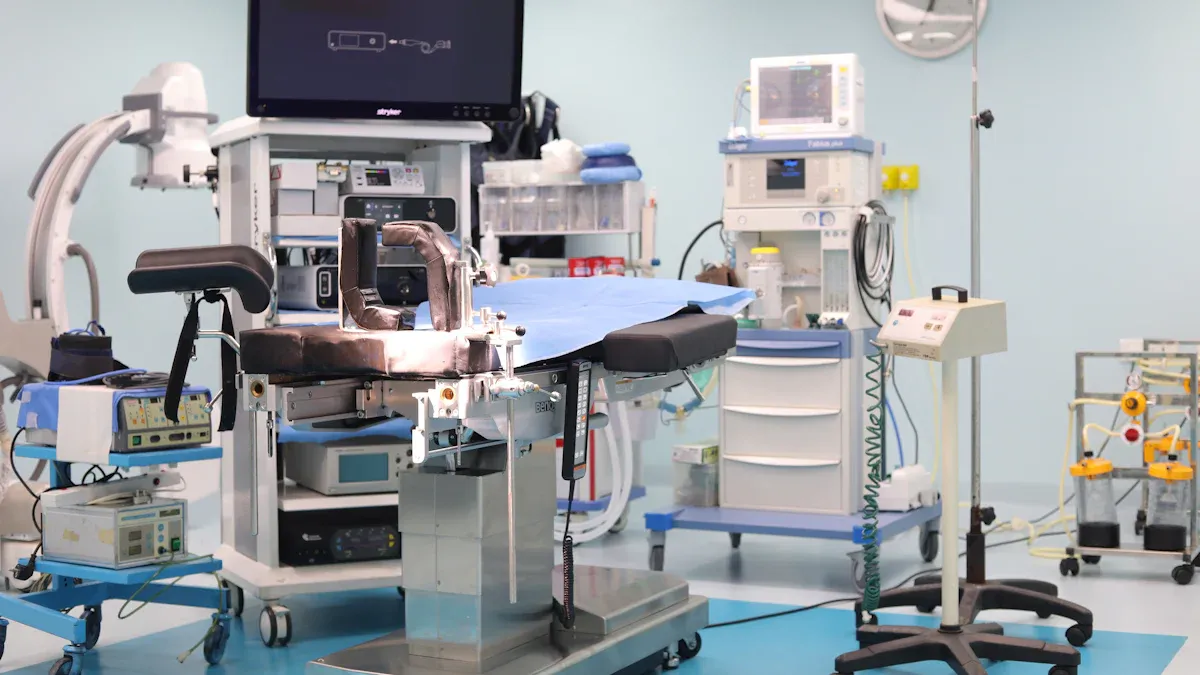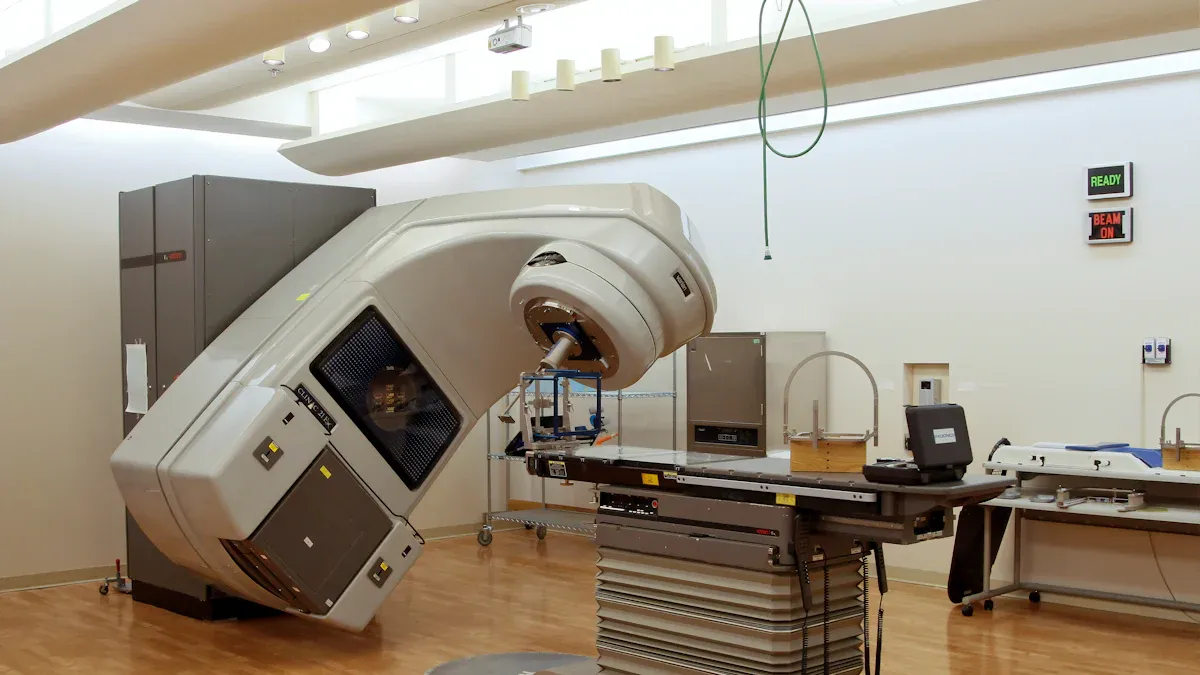The Benefits of NiTi Robotic Surgical Instruments Over Traditional Tools

Modern surgical advancements have introduced tools like NiTi robotic surgical instruments, which offer unmatched precision and flexibility. These instruments excel in performing minimally invasive procedures, reducing the risks associated with traditional methods. By leveraging robotics, they enhance safety and performance in surgery, allowing surgeons to work with greater accuracy. You benefit from faster recovery, less trauma, and a higher standard of care. Unlike traditional tools, NiTi-based robots adapt to complex procedures with ease, making them indispensable in the operating room. Their innovative design prioritizes both patient outcomes and surgeon comfort.
Key Takeaways
NiTi robotic tools are very precise, helping surgeons do delicate work accurately.
Using NiTi tools in small surgeries helps patients heal faster with less pain.
NiTi tools are easy to handle, so surgeons feel less tired and can focus better.
Robots make surgeries safer by improving how tools move and work together.
Using NiTi robotic tools helps create new surgery methods for better patient care.
Understanding NiTi Robotic Surgical Instruments

Properties of Nickel-Titanium Alloy
Nickel-Titanium (NiTi) alloy stands out due to its unique mechanical and physical properties. Its flexibility and shape-memory capabilities make it ideal for surgical applications. You’ll find that NiTi adapts to complex movements, ensuring precision during procedures. Scientific research highlights its biocompatibility, which minimizes risks when used in the human body.
Property | NiTi-1 (Commercial) | NiTi-2 (Continuous Cast) |
|---|---|---|
Hardness | Lower | Higher |
Ni Ion Release (pH 2.3) | Higher | Lower (2x lower) |
Ti Ion Release (pH 2.3) | Higher | Lower (3x lower) |
Biocompatibility (MTT Test) | No significant difference | No significant difference |
This table demonstrates how NiTi alloys vary in hardness and ion release, with continuous cast NiTi offering superior performance. These properties enhance surgical instrument detection and tracking accuracy, ensuring reliable outcomes in robot-assisted surgery.
Role of Robotics in Modern Surgery
Robotics has transformed surgery by introducing precision and efficiency. Nearly half of neurosurgeons now use robot-assisted systems, reflecting their growing importance. You’ll notice that robotic systems improve surgical navigation and guidance, reducing complications and enhancing outcomes. Younger surgeons are leading this shift, embracing robotic instruments for their advanced capabilities.
Robotics also supports image-guided surgery, where an image guidance system helps track and navigate surgical tools. This technology ensures accurate instrument tracking, even in complex procedures. By integrating robotics, you gain access to tools that prioritize both patient safety and surgeon comfort.
Applications of NiTi in Surgical Robots
NiTi alloys play a crucial role in surgical robots. Their flexibility allows robotic instruments to maneuver through intricate pathways during minimally invasive procedures. You’ll see these alloys used in robot-assisted surgeries, where their shape-memory properties ensure consistent performance.
NiTi-based tools excel in image-guided surgery, offering precise navigation and guidance. Their biocompatibility reduces patient trauma, while their durability ensures long-term reliability. These features make NiTi alloys indispensable in robotic systems, driving innovation in surgical instrument detection and tracking technologies.
Advantages of NiTi Robotic Surgical Instruments Over Traditional Methods

Superior Precision and Accuracy
NiTi robotic surgical instruments offer unmatched precision during surgery. Their advanced design allows you to perform delicate procedures with exceptional accuracy. The shape-memory properties of NiTi ensure that these robotic instruments maintain their form and function even in complex surgical environments. This level of precision reduces the risk of errors, ensuring better outcomes for patients. Unlike traditional methods, these instruments adapt seamlessly to intricate movements, making them ideal for robot-assisted surgery. With enhanced tracking and guidance systems, you can navigate surgical tools with confidence, even in challenging scenarios.
Minimally Invasive Procedures and Faster Recovery
Minimally invasive procedures have become a cornerstone of modern surgery, and NiTi robotic surgical instruments excel in this area. These tools allow you to perform surgeries through smaller incisions, reducing trauma to the surrounding tissues. Patients benefit from shorter hospital stays, less pain, and faster recovery times. The flexibility of NiTi alloys enables surgical robots to access hard-to-reach areas without causing unnecessary damage. By minimizing invasiveness, you can improve patient satisfaction and reduce the overall risks associated with surgery.
Enhanced Surgeon Control and Reduced Fatigue
Robotics has revolutionized the way you perform surgeries by enhancing control and reducing physical strain. NiTi robotic surgical instruments provide you with intuitive controls and precise feedback, allowing for smoother and more efficient procedures. The ergonomic design of these tools minimizes fatigue, enabling you to focus on delivering the best possible care. Traditional methods often require repetitive motions that can lead to discomfort or long-term injuries for surgeons. With robotic systems, you can work comfortably and maintain peak performance throughout lengthy procedures.
Challenges in Traditional Methods Solved by NiTi Robotic Tools
Addressing Ergonomic Issues for Surgeons
Traditional surgical tools often require repetitive motions and awkward hand positions. These factors can lead to fatigue, discomfort, and even long-term injuries for surgeons. NiTi robotic instruments solve these issues by offering ergonomic designs and intuitive controls. You can perform procedures with greater ease and precision, reducing physical strain. Robotics enhances your ability to maintain steady movements during lengthy surgeries, ensuring consistent performance.
With robotic systems, you gain tools that prioritize your comfort and efficiency. This improvement allows you to focus entirely on delivering the best care to your patients.
Reducing Patient Trauma and Blood Loss
Traditional surgery methods often involve larger incisions, which can cause significant trauma and blood loss. NiTi robotic instruments enable minimally invasive procedures, allowing you to operate through smaller incisions. These tools reduce damage to surrounding tissues and minimize bleeding. Patients experience shorter recovery times and less post-operative pain.
The flexibility of NiTi alloys ensures precise navigation through complex anatomical structures. This precision reduces the risk of complications and improves overall surgical outcomes. By using robotic systems, you can achieve better results while prioritizing patient safety.
Overcoming Limitations in Complex Surgeries
Complex surgeries often challenge traditional tools due to their limited range of motion and precision. NiTi robotic instruments excel in these scenarios. Their shape-memory properties and flexibility allow you to navigate intricate pathways with ease. Surgical robots equipped with advanced tracking and guidance systems enhance your ability to perform delicate procedures.
For example, in minimally invasive surgeries, NiTi tools provide consistent performance even in challenging environments. Robotics ensures accurate detection and navigation, enabling you to address complex cases with confidence. These advancements make it possible to tackle procedures that were once considered too risky or difficult.
Broader Impacts of NiTi Robotic Surgical Instruments
Improving Surgical Efficiency and Outcomes
NiTi robotic surgical instruments significantly enhance the efficiency of surgical procedures. Their advanced design allows you to perform complex surgeries with greater speed and accuracy. The shape-memory properties of NiTi ensure that these instruments maintain their functionality even in challenging environments. This reliability reduces the time spent on adjustments during surgery, enabling you to focus on achieving the best outcomes.
Robotics also improves surgical instrument detection and tracking, ensuring precise navigation throughout the procedure. With enhanced guidance systems, you can minimize errors and optimize results. These advancements not only improve efficiency but also contribute to better patient outcomes, making surgeries safer and more effective.
Enhancing Patient Satisfaction and Recovery
Patients undergoing minimally invasive procedures with NiTi robotic instruments report higher satisfaction levels. These tools allow you to perform surgeries through smaller incisions, reducing trauma and promoting faster recovery. Patients experience less pain, shorter hospital stays, and quicker returns to daily activities.
Surveys highlight the impact of advanced surgical techniques on patient satisfaction:
Satisfaction after cognitive behavioral therapy-based comprehensive nursing interventions reached 95.12%.
Routine behavioral interventions achieved an 87.18% satisfaction rate.
The difference was statistically significant (P < 0.05), showcasing the benefits of innovative approaches.
By prioritizing minimally invasive methods, you can enhance patient experiences and improve overall recovery rates.
Driving Innovation in Robotic Surgery
NiTi robotic surgical instruments play a pivotal role in advancing robotics in medicine. Their unique properties inspire the development of cutting-edge technologies, pushing the boundaries of what robotic systems can achieve. You’ll notice that these innovations improve not only the tools themselves but also the overall surgical process.
For example, advancements in tracking and guidance systems have made it possible to perform surgeries that were once deemed too complex. These tools also encourage collaboration between engineers and medical professionals, fostering a culture of innovation. By adopting NiTi-based robotic instruments, you contribute to the ongoing evolution of robotic surgery, ensuring better care for future generations.
NiTi robotic surgical instruments offer unmatched precision, enabling you to perform minimally invasive procedures with ease. These tools reduce patient trauma and improve recovery times, ensuring better outcomes. By addressing the limitations of traditional methods, they enhance both surgeon efficiency and patient care. Their innovative design and advanced capabilities make them a cornerstone of modern surgery. You can explore these technologies further to revolutionize the way surgeries are performed. Embracing NiTi-based robotic systems ensures you stay at the forefront of medical advancements.
FAQ
What makes NiTi robotic surgical instruments better than traditional tools?
NiTi robotic instruments offer unmatched precision, flexibility, and minimally invasive capabilities. These tools reduce patient trauma, improve recovery times, and enhance surgeon control. Their shape-memory properties and biocompatibility make them ideal for complex surgeries, ensuring better outcomes compared to traditional methods.
Are NiTi robotic surgical instruments safe for patients?
Yes, NiTi alloys are biocompatible and safe for use in the human body. Their unique properties minimize risks like tissue damage or allergic reactions. These instruments also reduce blood loss and trauma during surgery, ensuring a safer experience for patients.
How do NiTi robotic tools improve surgeon performance?
NiTi robotic instruments provide ergonomic designs and intuitive controls. These features reduce physical strain and fatigue during lengthy procedures. Their precision and flexibility allow you to perform complex surgeries with greater ease, ensuring consistent performance and better results.
Can NiTi robotic instruments be used for all types of surgeries?
NiTi robotic tools excel in minimally invasive and complex surgeries. They are commonly used in neurosurgery, cardiovascular procedures, and orthopedic operations. However, their application depends on the specific surgical requirements and the availability of robotic systems.
Do NiTi robotic instruments require special training for surgeons?
Yes, surgeons need specialized training to operate robotic systems effectively. Training ensures you understand the controls, navigation, and capabilities of NiTi robotic instruments. This preparation helps you maximize the benefits of these advanced tools and deliver optimal patient care.
See Also
NiTi Tubes Transforming The Future of Medical Devices
Nitinol Tubing: A Key Component for Minimally Invasive Techniques
Nitinol Tubing's Impact on Modern Medical Device Innovation
Nitinol Tubing Applications: Enhancing Healthcare Device Functionality
Advancing Medical Technology Through Nitinol Tubing Innovations

